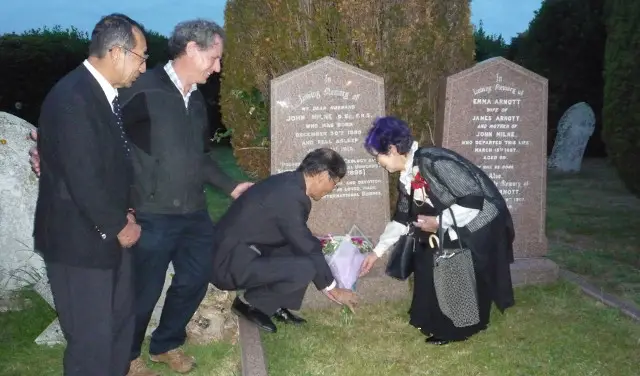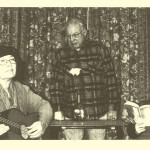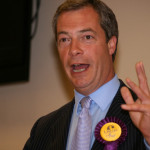Thanks to Suzanne and Alan for this report from the John Milne Centenary celebrations. Ed
When world renowned seismologist John Milne died one hundred years ago it was front page news the next day. ‘Earthquake Wizard Dead’ proclaimed the Daily Mirror on 1st August, 1913.
Born in Liverpool on 30th December, 1850 he was raised in Rochdale, where now a public house bears his name. He was proud of the fact that he never lost his Lancashire accent.
Between 1876 and 1895 Professor John Milne put Japan at the forefront of modern science with his study of earthquakes. In July 1895 he settled at Shide on the Island as his mother, due to ill health, planned to move to the Isle of Wight.
Based in Shide
Shide Hill House, outside Newport, became the base for his research. Most of the Milne estate has now gone but the gatehouse remains.
Now called Shide Lodge it was purchased by the Robinson family in 1978. It was only later that they learnt of its role in history.
Thanksgiving service
Following John Milne’s death on 31st July 1913 he was buried at St. Paul’s Church, Barton in a grave next to his mother. On the centenary of his death the church was the venue for a service of thanksgiving for his life and work.
This service was led by the Rev. Dr. Peter Pimentel with an address by the Bishop of Portsmouth the Right Reverend Christopher Foster and a detailed history of Milne’s life on the Island researched and presented by Richard Smout.
Milne’s mother Emma, buried alongside her son at St. Paul’s, Barton cemetery has a headstone bearing the name of Emma Arnott as a result of her second marriage. Born Emma Twycross she was one of 12 siblings and her father was one time Mayor of Wokingham.
Three Twycross siblings settled in Australia and started up a wool exporting business, which benefited Emma Milne’s first husband whose family was in the wool trade in the UK.
‘The Man Who Mapped the Shaking Earth’
A descendant of the Australian Twycross family is Dr. William Twycross has narrated a 63 minute film ‘The Man Who Mapped the Shaking Earth’. William, who was born in Melbourne, is a practising G.P. in Australia. In his younger days he was employed by the Flying Doctor Service.
As John Milne and his Japanese wife Tone had no children there are no direct Milne descendants.
Milne Centenary celebrations
As part of the Milne Centenary celebrations a contingent of the Twycross family, led by William travelled from Australia to the UK for lectures and meetings based on the life of John Milne.
Visiting the Island played a special part in their visit and as part of the current exhibition being staged in the Carisbrooke Castle Museum, which was opened by the Japanese Ambassador earlier this year, the Twycross family has sponsored a special room, aside the main exhibition area, where excerpts of the film can be viewed. (If anyone visiting Carisbrooke Castle Museum wishes to view the full film this can be requested from the Museum’s desk.) A special showing of the film also took place at Quay Arts.
In opening the Milne-Twycross audio-visual room William said how Milne had made great links with Japan and Judi Griffin, Chairman of the Museum Trustees, reiterated how friendship between the UK and Japan through such endeavours played a part in knowledge of different cultures.
‘Cutting the ribbon’
William was assisted in the ‘cutting the ribbon’ opening ceremony by Professor Kato. In addition to the Twycross family several eminent seismologists from both the UK and Japan visited the Island for this special occasion.
In 1896, and now living at Shide, John Milne was a founder member of Newport Golf Club. He was the club captain from 1903-1913. Milne was known for his joking and he trained his dog Billy to retrieve golf balls. Most people did not realise the balls were coated in aniseed which attracted Billy to them. As a mark of respect for their captain in 1914 the Golf Club started an annual tournament for the John Milne Memorial Cup. This year’s event was won by Steve Newman.
Continuing at Carisbrooke Castle Museum until October the exhibition and new audio-visual room are well worth a visit.





